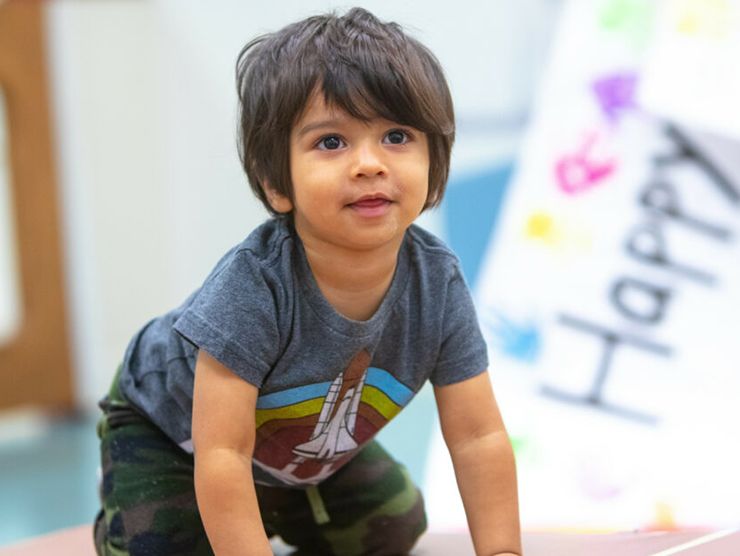Sleep is a popular topic—particularly among parents. “Is he sleeping through the night?” and “I was up all night with the baby,” are popular conversation starters among parents, especially new parents. In response, there is no shortage of advice from blogs, social media, and books on the topic of sleep.
Sleep routines and patterns are deeply personal and greatly impacted by one’s background, culture, family beliefs, and past experiences. There is not a “one-size-fits-all” answer for improving the quality and quantity of sleep. Rather than changing with each new fad, or the latest advice, each person and family should find solutions to fit their lifestyles.
Here are three simple, easy to implement ideas for your bedtime routine that may help improve the quality of sleep for you and your child, and can easily integrate with your family’s way of life:
- Keep a Bedtime Routine
- Avoid Screen Time Before Bed
- Create a Bedroom Environment for Good Sleep
Keep a Bedtime Routine
Routines are integral to encouraging positive sleep health; they do not have to be rigid, but should follow a predictable pattern. Work days may follow a different pattern than weekends, and of course planned events and late evenings transpire as well. When you encounter a later than usual night with your child, resist the urge to bypass routine completely. An overtired child (and adult) needs even more strategies or support to calm down. Keep the same integral pieces of your typical schedule in place, but spend a little less time on each. Read a shorter book, wash up with some running water, or share a less complicated bedtime story.
A simple routine to follow is keeping to the same bedtime and wake time each day. While this is not always possible in our busy lives, try to resist the urge to sleep in on weekends, which sets off the sleep-wake pattern. As you find the bedtimes that work for your household, follow a reliable and predictable pattern each night. This way one’s body begins to recognize cues and prepare for slumber.
Involve older children in planning what happens before bed. Some children relax with an evening bath, a story, or a little quiet dedicated child-parent time. Others might enjoy some guided imagery and a few restful yoga poses. Together, you and your child may enjoy a few moments of meditation or stretching before bed. As your child becomes familiar with a routine, he can gently start to guide himself into relaxation and recognize his own sleep cues. As your child grows, he will stick to some of these strategies and take initiative for developing his own bedtime routine.
Your own evening routine is also important. What do you do after putting your child to bed? What do you find relaxing? Try to incorporate your favorite calming experiences into your bedtime routine.
Avoid Screen Time Before Bed
According to the Harvard Health Letter from Harvard Health Publishing, the artificial blue light from electronic devices delays the production of sleep-inducing melatonin and impacts the body’s natural circadian rhythm. This negatively impacts one’s ability to fall asleep. To counteract this impact, avoid screen time two to three hours before bed. For children this means turning off television and iPads several hours before bedtime. For adults, this can be more challenging. Consider using an app that filters the blue. Try keeping televisions, phones, and computers out of the bedroom help to make this easier to accomplish. During the day, be sure to spend plenty of time exposed to natural light — that will help set your circadian rhythm so your body is alert when it’s light and naturally transitions to slumber at night.
Create a Bedroom Environment for Good Sleep
Lastly, having a dedicated space that is conducive to quality sleep is important. Consistent with the rationale that routines help facilitate more restful sleep, a reliable, dedicated sleeping spot helps both adults and children associate sleep with that particular space. These spaces should be dark at night, and, when possible, cooler in temperature.
There is no magic cure to securing a restful night of slumber. However instituting some of these strategies may slowly encourage a more restorative sleep experience for you and your family.
Bright Horizons Sleep Webinar
Grab a cup of coffee and watch Dr. Craig Canapari, MD, pediatrician specializing in the care of children with sleep and breathing problems at Massachusetts General Hospital for Children, to find out how to get your children to go to sleep and stay asleep. He answers a variety of questions about sleep and provides tips and strategies for giving your whole family a good night's sleep.
More on Sleep
- Download our Sleep Resources.
- Here are 10 tips from our Mom bloggers on how to make bedtime run smoothly.
- Going on vacation? Read about helping children to sleep while on vacation.
- How much naptime do children need?





